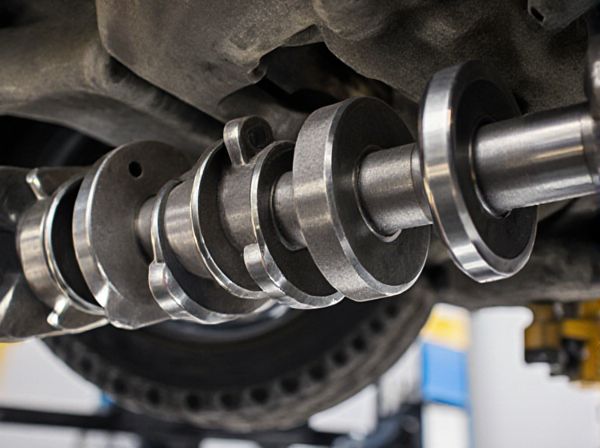
Photo illustration: Fully Counterweighted Crankshaft vs Partially Counterweighted Crankshaft
A fully counterweighted crankshaft offers superior balance by offsetting the weight of the connecting rods and pistons entirely, resulting in smoother engine operation and reduced vibrations. A partially counterweighted crankshaft, however, only balances a portion of this mass, which may lead to increased engine wear and less efficient performance. Choosing a fully counterweighted crankshaft can enhance your engine's durability and overall driving experience.
Table of Comparison
| Feature | Fully Counterweighted Crankshaft | Partially Counterweighted Crankshaft |
|---|---|---|
| Balance | Complete balance of rotating and reciprocating masses | Partial balance, mainly rotating masses balanced |
| Vibration | Minimal engine vibration and smoother operation | Higher vibration levels due to incomplete counterweighting |
| Engine Longevity | Reduced wear on bearings and components, longer lifespan | Increased bearing stress, potentially shorter component life |
| Performance | Improved high RPM performance and engine efficiency | Limited high RPM capability due to imbalance |
| Weight | Heavier due to full counterweights | Lighter crankshaft design |
| Cost | Higher manufacturing cost | Lower manufacturing cost |
| Common Usage | High-performance and luxury vehicles | Economy and standard passenger vehicles |
Introduction to Counterweighted Crankshafts
Counterweighted crankshafts are designed to balance the rotational forces within an engine, improving smoothness and reducing vibration. Fully counterweighted crankshafts incorporate counterweights on all crank throws, enhancing overall engine balance and durability, while partially counterweighted crankshafts have fewer or smaller counterweights, often resulting in lighter weight but increased vibration. Understanding the degree of counterweighting is essential for optimizing engine performance and longevity based on specific application requirements.
What is a Fully Counterweighted Crankshaft?
A fully counterweighted crankshaft features counterweights on all crank throws, which effectively balance the rotating assembly, reducing vibration and enhancing engine smoothness. This design improves overall engine durability and performance by minimizing stress on bearings and other components during high RPM operations. Engines with fully counterweighted crankshafts often exhibit better power delivery and increased longevity compared to those with partially counterweighted designs.
What is a Partially Counterweighted Crankshaft?
A partially counterweighted crankshaft features counterweights only on selected crank pins or journals to balance specific rotating masses while reducing overall weight compared to a fully counterweighted design. This design helps achieve a compromise between engine smoothness and mechanical efficiency by minimizing vibrations without excessively increasing the crankshaft's inertia. Typically used in smaller or less performance-demanding engines, partially counterweighted crankshafts lower production costs and improve throttle response due to their lighter mass.
Key Differences Between Fully and Partially Counterweighted Crankshafts
Fully counterweighted crankshafts feature weights balanced around the entire crankpin and crank web, significantly reducing engine vibration and enhancing smoothness at high RPMs. Partially counterweighted crankshafts have smaller or fewer counterweights, resulting in less effective vibration dampening but reduced overall mass, which may benefit certain performance applications. The key difference lies in the degree of balance correction, impacting engine durability, NVH (noise, vibration, and harshness) levels, and the suitability for high-performance or heavy-duty engine configurations.
Advantages of Fully Counterweighted Crankshafts
Fully counterweighted crankshafts provide superior balance by evenly distributing mass along the shaft, reducing engine vibrations and enhancing smooth operation. This improved balancing minimizes wear on engine components, extends engine life, and enables higher RPM limits for better performance. Enhanced stability from full counterweights also results in increased fuel efficiency and reduced mechanical stress compared to partially counterweighted crankshafts.
Advantages of Partially Counterweighted Crankshafts
Partially counterweighted crankshafts offer reduced rotational mass, which enhances engine response and acceleration by decreasing inertia. They also improve fuel efficiency due to lower internal friction compared to fully counterweighted designs. This type of crankshaft is advantageous in high-revving engines where rapid throttle response and lightweight components are critical.
Performance Implications: Vibration and Engine Balance
A fully counterweighted crankshaft significantly improves engine balance by evenly distributing mass, reducing vibration and enhancing overall performance, especially at higher RPMs. In contrast, a partially counterweighted crankshaft may lead to increased engine vibrations and uneven forces, which can cause premature wear and reduced efficiency. Optimizing crankshaft counterweighting is critical for maximizing smoothness and longevity in high-performance engines.
Applications in Modern Automotive Engines
Fully counterweighted crankshafts are predominantly used in high-performance and heavy-duty modern automotive engines, where balancing engine vibrations is critical for durability and smooth operation at high RPMs. Partially counterweighted crankshafts find application in smaller, economy-focused engines where reducing manufacturing costs and weight is prioritized, and engine vibration tolerances are higher. Engine configurations such as inline-four typically employ partially counterweighted crankshafts, whereas V8 and larger-displacement engines benefit from fully counterweighted designs for enhanced balance and longevity.
Maintenance and Longevity Considerations
Fully counterweighted crankshafts provide enhanced balance and reduced vibrations, which significantly decreases wear on engine components and extends overall engine longevity. Maintenance for fully counterweighted crankshafts tends to be less frequent due to improved stability, minimizing the risk of bearing failure and crankshaft fatigue. In contrast, partially counterweighted crankshafts may require more regular inspections and maintenance to address increased vibration-related stress and potential premature component wear.
Choosing the Right Crankshaft for Your Engine
Choosing the right crankshaft involves evaluating the trade-offs between fully counterweighted and partially counterweighted designs. Fully counterweighted crankshafts offer smoother engine operation and reduced vibrations, ideal for high-performance or heavy-duty applications, while partially counterweighted crankshafts provide a lighter, more economical option suited for everyday driving environments. Engine balance, RPM range, and application-specific demands should guide the selection process for optimal performance and longevity.
 caratoz.com
caratoz.com